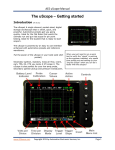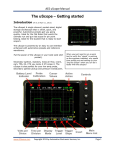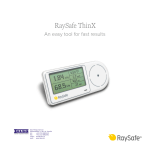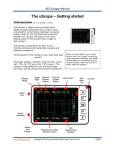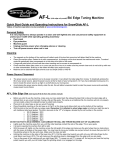Download YES OR NO AGREE OR DISAGREE COMMENTS Imaging Detector
Transcript
Digital Radiography System Schedule "D" – Technical Requirements & Questionnaire This section is highly technical and it is strongly recommended that you enquire (if not sure) as to the exact meaning of the question before submitting your response. Please ensure that your answers provide as much detail as possible. Answers to these questions are used as part of the evaluation process to determine the short list. Imaging Detector 1. State the dimension of the active imaging area for an upright Bucky. 2. Specify the dimension of the active imaging area for a table Bucky system. 3. State the material composition of the detector. 4. Specify the scintillating material. 5. What is the size of an individual detecting cell? 6. State the fill factor of the individual detecting cell. That is, what percent of the cell is actively receptive to the incoming photon fluence. 7. State the number of cells in the active imaging area. 8. Specify the number of reference detectors. 9. Specify the location of the reference detectors. 10. State the distance between individual cells. 11. Specify the maximum spatial resolution. 12. Specify dose to achieve the maximum spatial resolution. YES OR NO AGREE OR DISAGREE COMMENTS Digital Radiography System Schedule "D" – Technical Requirements & Questionnaire 13. Supply the MTF curve of the proposed system. This is a graph of the system performance as a function of the spatial frequency. State dose required to reproduce this curve. 14. Supply the DQE curve of the proposed system as a function of the spatial frequency. Specify dose required to reproduce this curve. 15. State the contrast ratio for this digital device. 16. Describe the methodology in obtaining the contrast ratio quoted above. 17. State the absorption efficiency. 18. State the thickness of the photoconductive layer. 19. State the limiting Nyquist frequency of your digital system. 20. Is the exposure dynamic range of your system linear? 21. Specify the sampling frequency of your system. (At what rate is the detector sampled for information?) 22. Specify the time taken for the image to appear on the technologist's console after irradiation of the plate. 23. For a multiple shot exam, what is the minimum time between exposures? 24. In the case of an upright Bucky, specify any angulations achievable. 25. In the case of a table Bucky, describe how cross table examinations are performed. 26. Describe the type of amplification used on the acquired signal. 27. Is the raw image data accessible for research purposes? Digital Radiography System Schedule "D" – Technical Requirements & Questionnaire 28. State your service response to a defective imaging array. Consider situations where dead space, inactive pixels, or shadowing from the previous image would be occurring. Image Grayscale Processing 1. Do you use contrast processing software? 2. Provide the generic name of the contrast processing software that you use on your system. 3. Is contrast processing a remapping of individual pixel values? 4. Is contrast processing applied to a filtered version of the original image and then reconstructed? 5. Do you use frequency processing on the acquired images? 6. Do you use Fourier filters for frequency image processing? 7. Do you use blurred-mask subtraction for frequency image processing? 8. Do you use wavelet filtering for frequency image processing? 9. List all image processing algorithms used on the acquired image. 10. State the bit depth of the processed image. Post-Processing Software 1. Describe all post-processing software that is currently available and comes standard with the system. Digital Radiography System Schedule "D" – Technical Requirements & Questionnaire 2. Describe all post-processing software that is currently available and comes as an option with this system. 3. Describe all post-processing software that will become available in the near future. Specify a tentative date of release and whether the software would become standard or be an option. 4. What is the bit depth of the postprocessed image? 5. What is the size of the post-processed image in terms of MB? Image Indicators 1. Describe all image indicators that appear on the final processed image. 2. Is image magnification clearly stated on the image? 3. Is latitude of the image data on the image? 4. Is the type of look up table parameters used for processing on the image? 5. Is the incident exposure information on the image? 6. Is the meaning of the image indicators clearly explained in the user's manual? 7. Specify the type and location of the patient demographics on the image. Computer System 1. Describe how images are deleted from your system. 2. When the memory is full, in what sequence do the images get deleted? Digital Radiography System Schedule "D" – Technical Requirements & Questionnaire 3. State the operating system. 4. Describe the monitors which would be placed in the individual clinics (make, model, luminance, resolution, whether monochrome or colour, etc.) 5. Can the same monitors used by CR in the clinical areas be used to view the DR images? 6. Do you supply a separate quality control system? 7. If so, please describe the system in detail. Quality Control/Quality Assurance 1. Do you supply a test tool to monitor basic measurements with your system? 2. Is this an option or does it come standard with the system? 3. List the basic measurements which this test tool monitors. 4. It is expected a quality control tool will be included with the purchase of this system. Do you agree? 5. Does the imaging physicist have access to the log data collected by the quality control test tool? 6. It is expected that the imaging physicist will have access to the quality control log acquired by the quality control test tool. Do you agree? 7. Does the quality control test tool come with an associated automated analysis software? 8. Does the system come with automated repeat/reject analysis software? Digital Radiography System Schedule "D" – Technical Requirements & Questionnaire 9. Describe how the technologist can keep track of repeats and rejects on your system. Acceptance Testing 1. The senior engineer qualified for this modality must be present during testing. Do you agree? 2. State the name and qualifications of the senior field engineer who will assist during acceptance testing, should yours be the successful proposal. 3. Any discrepancies or questions arising from this testing must be dealt with before first patient use. Do you agree? 4. The service engineer's test tool must be used, if it is not supplied with this system, as this will ensure accurate measurements during acceptance testing. Do you agree? 6. Other measurements might be made depending on the system delivered, improvements or additional technical information being received by the medical physicist prior to installation. The vendor will be made aware of any other measurements to be made well in advance of acceptance testing. Do you agree? Dose Management 1. Specify the range of the equivalent relative speed index achievable on your system. 2. Describe any dose savings mechanisms on your system. 4. What is the maximum exposure (in mGy) which will still yield an acceptable diagnostic image? Digital Radiography System Schedule "D" – Technical Requirements & Questionnaire 5. What is the maximum exposure in mGy your system can accept before saturation would occur? 6. Does your system have a safety mechanism to cut out if the exposure reading is too high? 7. Specify the theoretical maximum relative speed your system can achieve. Supply the DQE curve for this level. 8. At the lowest possible mAs, what is the minimum contrast level achievable by your system. State the mGy at this level. 9. Is the skin exposure does value available for each image taken? 10. Does this dose value become part of the patient demographics? Sensor Tracking System 1. Does your proposed system have sensor tracking? 2. Is the sensor mechanism ultrasonic or optical? 3. If neither ultrasonic or optical, specify the sensor tracking mechanism. 4. Describe the sensor tracking mechanism for your system. 5. Where is the sensor located at table side? 6. In the event the sensor tracking is nonfunctional, can the system still operate? That is, can the system still image without knowledge of the position of the x-ray tubetable distance. 7. Describe any safety features of your tracking system. Digital Radiography System Schedule "D" – Technical Requirements & Questionnaire 8. Does the table move when the tracking system is engaged? 9. State for which exams the table would move while tracking is operational. 10. In the event of a sensor malfunction, is manual override an option? Table 1. Indicate table height (min/max) from floor level. 2. Indicate table maximum longitudinal movement. 3. Indicate table maximum lateral movement. 4. Indicate maximum patient weight at maximal table extension. 5. Indicate additional weight allowed to administer tabletop CPR. 6. Indicate composition of tabletop. 7. Specify the equivalent filtration in terms of mmAl of the tabletop. Also specify at what kVp the measurement was made. 8. Are the materials used in the tabletop homogeneous? 9. Are there any areas in the tabletop where different densities would occur? 10. If so, specify exact areas of varying densities and equivalent mmAl filtration values. 11. Indicate list of included accessories delivered with the system. 12. Indicate name of manufacturer. Digital Radiography System Schedule "D" – Technical Requirements & Questionnaire 13. Indicate country of origin. Generator 1. What is the design of the proposed generator? 2. What is the power consumption for the large focal spot? 3. What is the power consumption for the small focal spot? 4. Does microprocessor store or visually indicate faulty operation? 5. By what mechanism is the user informed of a faulty generator operation? 6. Does generator include an interactive heat unit calculator? 7. State kVp accuracy as a percentage. 8. This will be measured during acceptance testing. Number stated above will be used as a baseline measurement. Do you agree? 9. State mA accuracy as a percentage. 10. This will be measured during acceptance testing. Number stated above will be used as a baseline measurement. Do you agree? 11. State voltage ripple at any kVp setting as a percentage. 12. This will be measured during acceptance testing. Service engineer must bring an oscilloscope during acceptance testing to make this measurement. Value stated above will be used as a baseline. Do you agree? 13. Supply a graph of the kVp pulse from an actual measurement. Digital Radiography System Schedule "D" – Technical Requirements & Questionnaire 14. Is kV accuracy maintained if line variations of more than ±10% are experienced during exposure? 15. If it does not, what extra component must be introduced to stabalize the system? 16. In the event of more than 10% power fluctuations during use, what would be the result in terms of functionality of the system? 17. Are the generator kV selections in steps or continuously variable? 18. What is the highest mAs selection available? 19. State the range of kV for the above mAs. 20. What is the lowest mAs available? 21. State the kV range for the above mAs. 22. Is the mAs selection of the x-ray generator in steps or continuously variable? 23. Does choice of radiographic values selection include: (a) kV, mA, time (b) kV, mAs (c) kV with automatic exposure time (d) other, describe 24. Does generator select automatically the correct focal spot size based on the mA selected? 25. Does generator include post-indication of exposure time? 26. Does generator include post-indication of mAs? 27. Is generator equipped with overload tube protection? Digital Radiography System Schedule "D" – Technical Requirements & Questionnaire 28. What is the required procedure for the tube to be functional, once it has overheated? 29. Specify number of distinct anatomical programs provided. 29. Is program choice indicated in clear simple English? 30. Does one distinct anatomical program selection include kV, focal spot, mAs, photocell pick-up and density setting? 31. Is the anatomical program userprogrammable without computer programming knowledge? 32. Can the user programme the anatomical preferences? If not, who can? 33. Does generator have self-diagnostic features built into the electronic design? Describe the features, if available. 34. Who has access to the generator selfdiagnostics features? 35. Are error messages displayed on the console? 36. State year of FDA approval. 37. State country of manufacturer. 38. State name of manufacturer. X-Ray Tube 1. State the anode speed. 2. State the anode focal spot track diameter. This is not the same as the anode diameter. 3. Specify anode composition. Digital Radiography System Schedule "D" – Technical Requirements & Questionnaire 4. Indicate anode coating used. 5. State anode diameter. 6. State the number of focal spots available and their respective sizes in terms of the latest IEC/NEMA measurement standards. 7. State the anode angle. 8. State anode heat dissipation rate. 9. If the x-ray tube is liquid cooled, state cooling liquid used. 10. State housing heat dissipation rate. 11. Describe the anode bearings (metal, liquid, etc.) 12. Is the x-ray tube grid switched? 13. Indicate year of FDA clearance. 14. State name of manufacturer. 15. State country of origin. Collimator 1. Describe the base thickness of copper and aluminum available on your system. 2. Is additional copper filtration available, beyond the value quoted above? 3. Is the additional copper filtration user programmable? 4. Can an additional fixed copper filtration thickness be selected at installation? 5. State the minimum and maximum opening dimensions of the collimator. 6. If your system has sensor tracking, does the collimator also adjust Digital Radiography System Schedule "D" – Technical Requirements & Questionnaire automatically depending on the anatomical program? 7. Describe the collimator blade shape. 8. State the composition of the collimator blades. Post-Processing Image Analysis and Computer Architecture 1. Specify CPU. 2. Specify operating system. 3. Specify architecture. 4. Specify RAM supplied. 5. Describe video card supplied with this system. 6. What is the maximum RAM available for this system? 7. Is post-processing software outsourced? 8. Who is the developer of all software provided with the system? 9. Specify storage media proposed. 10. List and describe all post-processing image analysis software currently available but not yet described. 11. State the restrictions, if any, for image processing and digital acquisition to function concurrently. 12. Can patient images be burned to a CD or DVD without patient demographics for teaching purposes? 13. Can patient images be burned to a CD or DVD as JPEG, GIF, DCM, BMP, etc for teaching files? Digital Radiography System Schedule "D" – Technical Requirements & Questionnaire 14. Is a CD or DVD burner supplied with your system? Digital Acquisition System and Viewing Monitors The computer system quoted controlling the complete DR system must be state-ofthe-art and easily upgradable and have more than sufficient memory and speed. 1. Indicate computer technology. 2. Indicate image processor technology and speed. 3. State size of true acquisition matrix. 4. State average image reconstruction time for the image matrix size quoted above. 5. Indicate system hard disk capacity (GB). 6. Indicate system hard disk capacity in terms of image matrix size quoted above. 7. Indicate system back-up/archival procedure. Describe any connectivity issues. 8. Specify and describe supplied shortterm system archival/back-up devices (i.e. tape, optical disk, CD, DVD….). 9. Indicate system power requirements. 10. Indicate temperature and relative humidity requirements needed for the DR suite to function optimally. 11. Indicate temperature and relative humidity requirements needed for the computer/mechanical room. 12. Indicate technology of all display Digital Radiography System Schedule "D" – Technical Requirements & Questionnaire monitors (grid, comb, etc.). 13. Indicate technology of command console. 14. Specify pixel matrix size for each monitor. 15. Specify resolution in lp/mm of all monitors. 16. Specify luminance of each monitor. 17. Luminance of each monitor will be tested during acceptance. Values given above will be used as a baseline. Do you agree? 18. Are any monitors proposed true grayscale monitors? 19. What is the grayscale bit depth of each monitor, including the colour monitors. 20. Provide the refresh rate of every monitor. 21. Are any proposed monitors flat panel? 22. Describe, in detail (lp/mm, luminance, etc.), the flat panel displays for your system. 23. Can all computer systems proposed function concurrently? 24. If not, provide a list of non-concurrent functionalities. 25. Indicate year of FDA approval for each component. 26. Indicate manufacturer. 27. Indicate country of origin.















